Microsoft Word 2016 is a word processing application that allows you to create a variety of documents, including letters, resumes, and more. In this lesson, you'll learn how to navigate the Word interface and become familiar with some of its most important features, such as the Ribbon, Quick Access Toolbar, and Backstage view.
Getting to know Word 2016
Word 2016 is similar to Word 2013 and Word 2010. If you've previously used either version, then Word 2016 should feel familiar. But if you are new to Word or have more experience with older versions, you should first take some time to become familiar with the Word 2016 interface.
The Word interface
When you open Word for the first time, the Start Screen will appear. From here, you'll be able to create a new document, choose a template, and access your recently edited documents. From the Start Screen, locate and select Blank document to access the Word interface.
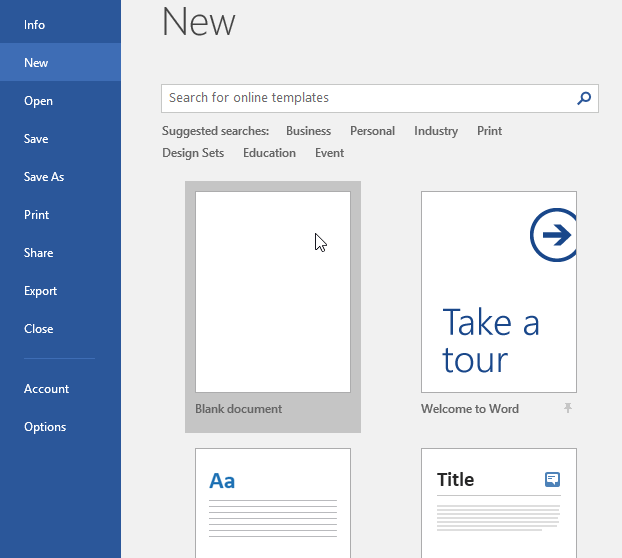
Click the buttons in the interactive below to learn more about the Word interface:
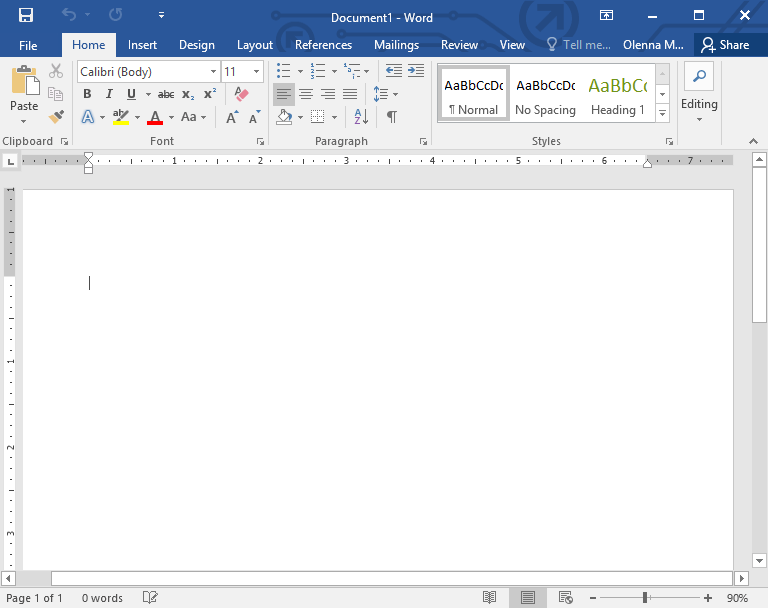
Working with the Word environment
Like other recent versions, Word 2016 continues to use features like the Ribbon and the Quick Access Toolbar—where you will find commands to perform common tasks in Word—as well as Backstage view.
The Ribbon
Word uses a tabbed Ribbon system instead of traditional menus. The Ribbon contains multiple tabs, which you can find near the top of the Word window.

Each tab contains several groups of related commands. For example, the Font group on the Home tab contains commands for formatting text in your document.

Some groups also have a small arrow in the bottom-right corner that you can click for even more options.
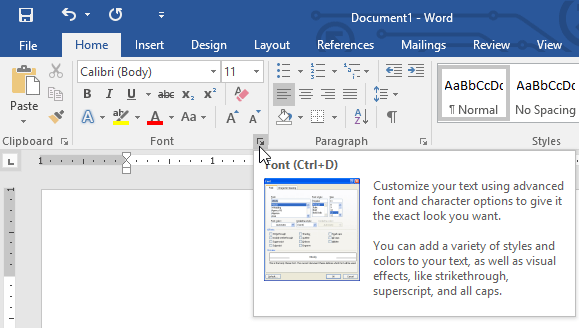
Showing and hiding the Ribbon
If you find that the Ribbon takes up too much screen space, you can hide it. To do this, click the Ribbon Display Options arrow in the upper-right corner of the Ribbon, then select the desired option from the drop-down menu:
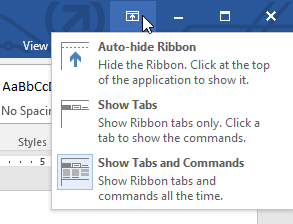
- Auto-hide Ribbon: Auto-hide displays your document in full-screen mode and completely hides the Ribbon from view. To show the Ribbon, click the Expand Ribbon command at the top of screen.
- Show Tabs: This option hides all command groups when they're not in use, but tabs will remain visible. To show the Ribbon, simply click a tab.
- Show Tabs and Commands: This option maximizes the Ribbon. All of the tabs and commands will be visible. This option is selected by default when you open Word for the first time.
Using the Tell me feature
If you're having trouble finding command you want, the Tell Me feature can help. It works just like a regular search bar: Type what you're looking for, and a list of options will appear. You can then use the command directly from the menu without having to find it on the Ribbon.
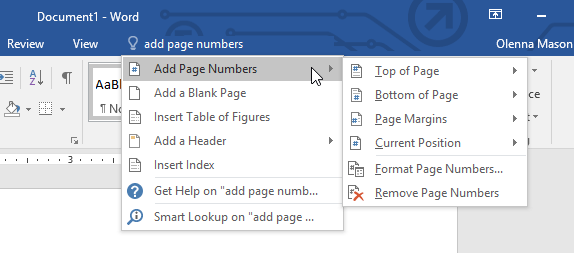
The Quick Access Toolbar
Located just above the Ribbon, the Quick Access Toolbar lets you access common commands no matter which tab is selected. By default, it shows the Save, Undo, and Redo commands, but you can add other commands depending on your needs.
The Ruler
The Ruler is located at the top and to the left of your document. It makes it easier to adjust your document with precision. If you want, you can hide the Ruler to create more screen space.


 Powerpoint 2016 Pro 64bit
1,521
Powerpoint 2016 Pro 64bit
1,521
 Excel 2016 (Pro 64bit)
1,607
Excel 2016 (Pro 64bit)
1,607
 Adobe Reader 11.0.23
4,223
Adobe Reader 11.0.23
4,223
 Beginners Guide: How To Install Ubuntu
4,998
Beginners Guide: How To Install Ubuntu
4,998
 Debut Video Capture Software free downlad online full version
3,403
Debut Video Capture Software free downlad online full version
3,403
 Free online slideshow maker with music and effects dowload free
4,183
Free online slideshow maker with music and effects dowload free
4,183
 Dowload microsoft office 2010 professional product key full crack
6,870
Dowload microsoft office 2010 professional product key full crack
6,870
 Snipping Tool++ online - Free download snipping tool windows 10, 7, 8
20,845
Snipping Tool++ online - Free download snipping tool windows 10, 7, 8
20,845
 PDF Reader allows you to open and view any pdf file
3,043
PDF Reader allows you to open and view any pdf file
3,043
 Microsoft word 2010 is installes on virtually every computer
2,771
Microsoft word 2010 is installes on virtually every computer
2,771
 Microsoft office 2010 debuted a collection of web-based versions
4,863
Microsoft office 2010 debuted a collection of web-based versions
4,863
 Microsoft Office 2011 home, business installation instructions
4,780
Microsoft Office 2011 home, business installation instructions
4,780
 Microsoft Office 2013 Professional Plus 15.0.4454.1002
6,446
Microsoft Office 2013 Professional Plus 15.0.4454.1002
6,446
 Foxit Reader 7.3.4.0311 - Read, edit and create PDF files for free
2,954
Foxit Reader 7.3.4.0311 - Read, edit and create PDF files for free
2,954
 Adobe Reader XI 11.0.10 - Tools best PDF reading
3,424
Adobe Reader XI 11.0.10 - Tools best PDF reading
3,424
 Free Webcam Recorder - Free download and software reviews
2,511
Free Webcam Recorder - Free download and software reviews
2,511
 Readiris Pro - Free download and software reviews
2,877
Readiris Pro - Free download and software reviews
2,877
 Gantt Chart Template for Excel - Free download and software reviews
3,945
Gantt Chart Template for Excel - Free download and software reviews
3,945
 Universal Document Converter - Free download and software reviews
2,739
Universal Document Converter - Free download and software reviews
2,739
 Soda PDF 3D Reader - Free download and software reviews
2,928
Soda PDF 3D Reader - Free download and software reviews
2,928
 Google Chrome Free...
166812
Google Chrome Free...
166812
 MathType 6.9a -...
79605
MathType 6.9a -...
79605
 Zalo for PC
29548
Zalo for PC
29548
 Beach Head 2002 -...
25730
Beach Head 2002 -...
25730
 iBackupBot - Free...
22595
iBackupBot - Free...
22595
 AnonymoX 2.0.2 -...
22177
AnonymoX 2.0.2 -...
22177
 Age of Empires 1.0
17040
Age of Empires 1.0
17040
 Realtek AC97 Audio...
16514
Realtek AC97 Audio...
16514
 Citrio...
14555
Citrio...
14555